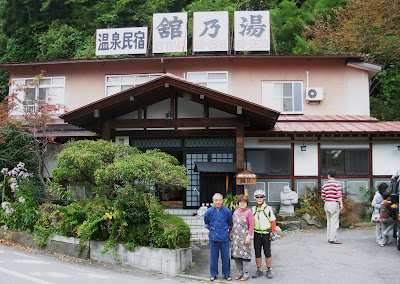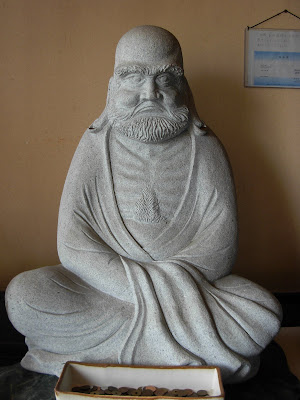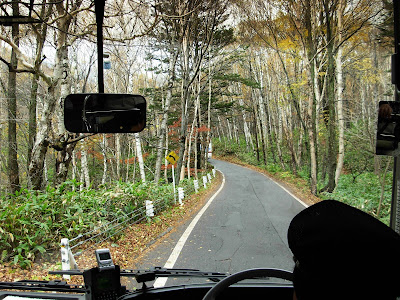
One of the major highlights of our tour is that each day's destination ended at an onsen. An onsen is a natural hotsprings bathhouse or an outdoor hotsprings pool.
In planning each day's route and destination, Jay and Andrew would look for an onsen first, then attempt to locate a campground, youth hostel or rider house close-by. Most times, this nice combo worked out.
The geologic activity that gives Japan it's earthquakes and volcanoes has also blessed it with an abundance of hotsprings. There are more than 3,000 natural hotsprings located through out Japan.
Onsen bathing is a major component of the Japanese lifestyle. Actually, it is more than a lifestyle activity, it borders on religious fervor.
Bathing and relaxing at an onsen at the end of the day was what made this bike tour so special and extraordinary. No stinkin' showers for us!
Onsens vary in terms of amenities, quality and age. Some are grand new modern bathhouses with granite tile floors, gleaming fixtures, multiple pools both indoor and outdoor at varying temperatures, waterfalls, jacuzzis, steam rooms and saunas. At the other end of the spectrum are simple facilities with only one pool. Most lie somewhere in between. The historic onsens, some more than 100 years old, were the best.
The onsens are segregated by gender. Some onsens are associated with ryokans (Japanese hotel), minshuku (bed and breakfast) and conventional hotels and many have restaurants. Most onsens have tatami rooms where you can cool off and relax after bathing.
The average day use cost of an onsen is about 500 yen ($5 US).
Note: To view enlarged photo, mouse over picture and click

How do you bathe at an onsen? There definitely is a formal protocal. You just don't jump into the pool without first thoroughly cleansing yourself.
The photo above shows you a typical washing station where you sit on a plastic stool and wash yourself - soap up, scrub yourself and rinse off - before entering a hot pool. Note liquid soap and shampoo are usually provided. Each station has it's own faucet and hand-held shower spray.

The onsen at this particular minshuku had one indoor pool and one outdoor hotspring pool located in a beautiful bonsai rock garden.

Here I am with the owners of a wonderful country bed and breakfast inn (minshuku) which had it's own small onsen.
The meals (breakfast and dinner) are included in the price of lodging and were some of the best I had on the tour.
Staying at minshukus and ryokans are a must-do experience when touring Japan.

The small mountain city of Kusatsu is the #1 hotspring destination in Japan. Within the city are numerous hotspring bath-houses and outdoor pools. Onsen hotsprings are the main economy of Kusatsu drawing 3 million visitors every year.
In the town square are the landmark wooden boxes (photo above and below) called Yubagatake which removes the sulphur and heavy metals before the hot water is piped to the hotspring facilities in the city.
The water flows down into each box which collect the heavy minerals. What comes out the other end is soft water which makes your skin tingle. We called it "magic water." I read that the theraputic waters will cure every ailment except a broken heart. This amazing ancient filtering system which pumps out 5,000 litres of water per minute has been in operation for over a 100 years.

Another view of the Yubagatake (wooden box filtering system). The central business district surrounds this unique town square.

The water cascades over a small cliff at the lower-end of the town square.
The Yubagatake is a major tourist attraction.

This large outdoor pool in Kusatsu is a wonderful place to catch the fall colors

Hidden away in the mountains of Northern Honshu is another famous onsen. This historic ryokan/onsen, over 100 years old, is a popular gettaway for harried city dwellers. The classic wooden hotel in a beautiful garden setting is quite spectacular.
We didn't stay here but only stopped to visit.

The impressive wooden portal into the ancient ryokan

View of the ryokan overlooking a lovely garden

The ryokan provides house slippers for guests to use when entering the hotel

The fountain spraying for a 100 years created this really neat moss island

Herb and I splurged one night and stayed at another 100 year old ryokan/onsen in the Northern Honshu mountains. The building was old and creaky and the floors tilted sideways. But it had so much wonderful character and history.

Checking into this classic old ryokan . . . the meals, ancient bathhouse and service were outstanding!

This modern building is one of the high-tone onsens we visited which featured multiple pools, sauna, exercise room, restaurant and many more nice amenities. Also a stunning view of the sunset though the expansive west-facing windows.

At the other end of the spectrum is this freebie outdoor hotsprings
we encountered in the mountains.
 Travelling through Japan, we came across a bunch of neat statues and plaques, either historic, funny or odd. Here is a sampling of what I thought were intriquing and worthy of posting.
Travelling through Japan, we came across a bunch of neat statues and plaques, either historic, funny or odd. Here is a sampling of what I thought were intriquing and worthy of posting.






















 The waterfall splits into two falls and drops into deep plunge hole.
The waterfall splits into two falls and drops into deep plunge hole.
 I lucked out and got a seat right behind the bus driver. I took a few shots out the front window of the changing colors on the drive up into the Alps.
I lucked out and got a seat right behind the bus driver. I took a few shots out the front window of the changing colors on the drive up into the Alps.
 Arriving in the Kamikochi Valley in the heart of the Alps.
Arriving in the Kamikochi Valley in the heart of the Alps.
 A couple neat pedistrian bridges crossing a river in the valley
A couple neat pedistrian bridges crossing a river in the valley

 The first dusting of snow of the season. Note the sprinkling of yellow cedar trees in the mountain-side.
The first dusting of snow of the season. Note the sprinkling of yellow cedar trees in the mountain-side.


 Here I am with the owners of a wonderful country bed and breakfast inn (minshuku) which had it's own small onsen.
Here I am with the owners of a wonderful country bed and breakfast inn (minshuku) which had it's own small onsen. The small mountain city of Kusatsu is the #1 hotspring destination in Japan. Within the city are numerous hotspring bath-houses and outdoor pools. Onsen hotsprings are the main economy of Kusatsu drawing 3 million visitors every year.
The small mountain city of Kusatsu is the #1 hotspring destination in Japan. Within the city are numerous hotspring bath-houses and outdoor pools. Onsen hotsprings are the main economy of Kusatsu drawing 3 million visitors every year.
 The water cascades over a small cliff at the lower-end of the town square.
The water cascades over a small cliff at the lower-end of the town square.
 Herb and I splurged one night and stayed at another 100 year old ryokan/onsen in the Northern Honshu mountains. The building was old and creaky and the floors tilted sideways. But it had so much wonderful character and history.
Herb and I splurged one night and stayed at another 100 year old ryokan/onsen in the Northern Honshu mountains. The building was old and creaky and the floors tilted sideways. But it had so much wonderful character and history. Checking into this classic old ryokan . . . the meals, ancient bathhouse and service were outstanding!
Checking into this classic old ryokan . . . the meals, ancient bathhouse and service were outstanding!